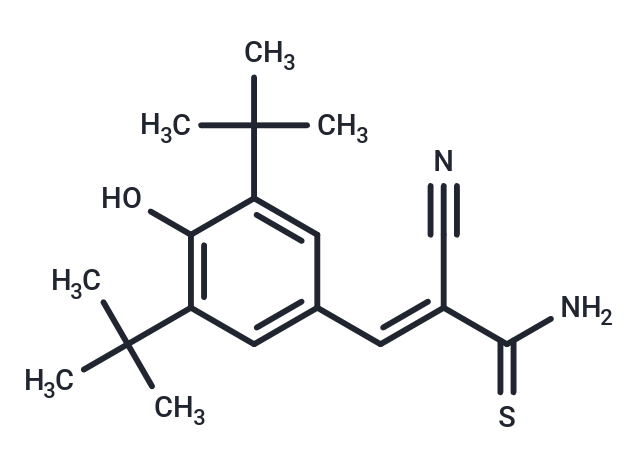Shopping Cart
- Remove All
 Your shopping cart is currently empty
Your shopping cart is currently empty
Tyrphostin AG 879 (AG 879) effectively inhibits HER2/ErbB2 with an IC50 of 1 μM, demonstrating 100- and 500-fold higher selectivity for ErbB2 over EGFR and PDGFR, respectively.

| Pack Size | Price | Availability | Quantity |
|---|---|---|---|
| 5 mg | $43 | In Stock | |
| 10 mg | $68 | In Stock | |
| 25 mg | $158 | In Stock | |
| 50 mg | $263 | In Stock | |
| 100 mg | $450 | In Stock | |
| 1 mL x 10 mM (in DMSO) | $48 | In Stock |
| Description | Tyrphostin AG 879 (AG 879) effectively inhibits HER2/ErbB2 with an IC50 of 1 μM, demonstrating 100- and 500-fold higher selectivity for ErbB2 over EGFR and PDGFR, respectively. |
| Targets&IC50 | HER2/ErbB2:1 μM |
| In vitro | AG879 inhibits growth of FET6αS26X cells in a concentration-dependent manner. [1] AG879(10 nM) blocks the activation of PAK1 and suppresses RAS-induced malignant transformation of NIH 3T3 cells. AG879(<1 μM) inhibits the Tyr-phosphorylation of ERK and its association with PAK1 in v-Ha-RAS-transformed NIH 3T3 fibroblasts. [2] AG 879 dose-dependently reduce MCF-7 cell numbers and show already a significant effect at 0.4 mM through inhibiting DNA synthesis and mitotic. AG 879(<20 μM) inhibits activation of ERK-1/2 in MCF-7 cell. AG 879(5 μM) decreases expression of Hsp90 client proteins RAF-1 and HER-2. [3] AG879(20 μM) dramatically decreases proliferation with a variable increase in apoptosis in Cell lines from human leiomyosarcoma (HTB-114, HTB-115, HTB-88), rhabdomyosarcoma (HTB-82, TE-671), prostatic adenocarcinoma (PC-3), acute promyelocytic leukemia (HL-60) and histiocytic lymphoma (U-937). [4] |
| In vivo | AG879(2 mg) induces a decrease in cancer growth in athymic NOD/SCID mice grafted with HTB-114 or HL-60. [4] AG 879(20 mg/kg) treatment keeps 50% of mice absolutely free of RAS-induced sarcomas, and dramatically reduces the size of the growing sarcomas in the nude mice carrying v-Ha-RAS transformed NIH 3T3 cells. [5] |
| Kinase Assay | AZD3759 is tested at a single 1 μM concentration across each of 124 kinases from Millipore kinase panel at an ATP concentration that is within 15 μM of their corresponding apparent Km values. In brief, recombinant kinases are incubated within an appropriate buffer containing peptide substrate and radiolabelled γ-33P-ATP together with presence or absence of required inhibitor concentration. The reaction is initiated by adding ATP/Mg2+ mix. After incubation for 40 minutes at room temperature, the reaction is stopped by adding 3% phosphoric acid solution. A portion of reaction mix is spotted onto P30 filter mat to trap peptide and washed three times for 5 minutes with phosphoric acid to remove non-specific γ-33P-ATP. The phosphorylated substrate is then measured by scintillation counting, which determined the level of kinase activity inhibition compared to control reactions[1]. |
| Cell Research | Cells are grown in 96-well plates containing 100 μL medium per well. Ten microliters of MTT solution (5 mg/ml in PBS) is added to each well and incubation continued for 4 h at 37 °C. Subsequently, 100 μL 10% SDS in 0.01 M HCl is added. After incubation at 37°C overnight, absorption is measured at 550 nm in an ELISA reader using a reference filter of 690 nm.(Only for Reference) |
| Synonyms | AG 879 |
| Molecular Weight | 316.46 |
| Formula | C18H24N2OS |
| Cas No. | 148741-30-4 |
| Smiles | CC(C)(C)c1cc(\C=C(/C#N)C(N)=S)cc(c1O)C(C)(C)C |
| Relative Density. | 1.161g/cm3 |
| Storage | Powder: -20°C for 3 years | In solvent: -80°C for 1 year | Shipping with blue ice/Shipping at ambient temperature. | ||||||||||||||||||||||||||||||||||||||||
| Solubility Information | DMSO: 31.7 mg/mL (100.17 mM), Sonication is recommended. Ethanol: 7.9 mg/mL (24.96 mM), Sonication is recommended. | ||||||||||||||||||||||||||||||||||||||||
Solution Preparation Table | |||||||||||||||||||||||||||||||||||||||||
Ethanol/DMSO
DMSO
| |||||||||||||||||||||||||||||||||||||||||

Copyright © 2015-2025 TargetMol Chemicals Inc. All Rights Reserved.